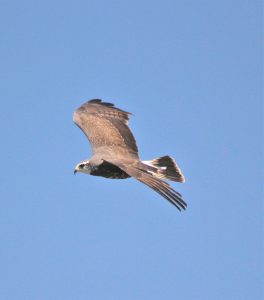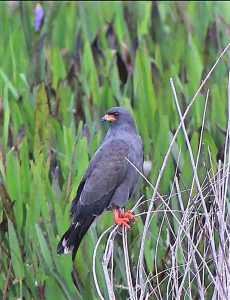
National Endangered Species Day is May 20, 2022, created by the U.S. Senate in 2006, this day of appreciation also coincides with World Endangered Species Day.
Florida Endangered list
Our state animal, the Florida Panther, is our most famous member of this group, today we want to talk about the Everglades Snail Kite bird. This bird is one of our local birds here in Osceola County.
Everglades Snail Kite
These few birds live in the shallow marshy areas of Lake Toho and they hunt for Apple Snails as they fly low, gliding above the marsh grasses and shallow waters where the snails are found. In addition they can found on Lake Okeechobee, the Loxahatchee, and the Everglades National Park.
What do the birds look like? How do you know if you see one?
- Usually about 15″ tall, snail kites are related to hawks and eagles.
- Their curved beaks are perfect for dining on snails.
- The snail kite beaks have up of two colors.
- With slate gray to black tips, the beaks are either orange or yellow elsewhere.
- The male birds have the orange coloration, along with orange legs and feet.
- The females and juveniles have the yellow beak coloration, along with yellow legs and feet.
- The male bird is a different color from a female also.
- Males are blue/gray, with darker flight feathers, while females are brown, also with darker flight feathers.
- Tails are a triangular shape in flight.
- The official description for both males and females are that the tail is white with a dark band. But at a distance, it can appear to be a dark tail with a white band. In any case, this banded tail quickly distinguishes the snail kite from a hawk or an osprey.
What about their diet?
While our native Apple Snails are declining, we also have 4 exotic ones, including the channeled apple snails, island apple snails, and giant apple snails. These are larger, and some are even able to tolerate man-made things such as retention ponds. Fortunately, the snail kites do not seem to care which kind of Apple snail they eat. To capture a snail, the snail kite often perches on some low vegetation until he spots one. He might also scan the area by air. Gliding slowly over the marsh, the kite swoops down and picks up a snail with one foot and carries it home. At some point, during the flight, the snail is transferred from the foot to the beak. After landing, the prey is once again held with one foot while the curved bill easily excavates the meat from its shell. Favorite dining spots are often decorated with a collection of large, empty shells.
Nest
Nests are a platform of soft stem wetland plants and sticks, built over water, in low trees or shrubs, and are usually 3 to 15 feet above the water. They are usually close to the unflooded area where the shell collections are found. In the past, 4 eggs were laid, but currently the number is 2-3 eggs, as less snails are available. The eggs hatch in 26-28 days (about 4 weeks), and the parents feed them snails for 9-11 weeks (about 2 and a half months). After 6-7 weeks (about 1 and a half months), the babies can fly.
But why are these birds endangered?
- The snail kite is on both the Federal and the State endangered list.
- Habitat loss and habitat degradation have had an impact on the snail populations.
- Disruption of water flow is a cause of this. Half of the Everglades area has been drained. The park includes and protects only one fifth of the actual Everglades.
- Water quality can also be a problem.
- Agricultural runoff and septic tank seepage can degrade the quality, which makes it more favorable for exotic and invasive plants. These plants can take over the snail habitat, making it impossible for the kites to see the snails, if there are any left.
- Drought will also affect the birds, as lower water levels allow nests to get attacked by predators. Snails also die from declining water levels.
- Actually, any disruption of natural water levels does not help, as the birds cannot hunt in water that is over 6 inches deep either.
- All of this can leave the birds with little to eat. While non-native snails are not allowed to be brought in, at least some of them can survive well enough to expand their habitat to unnatural areas, helping the birds.
What can we do?
Restoration is being worked on in the Everglades and larger lakes. Native wetland vegetation is being put back, and there are attempts to exterminate invasive plants. Perhaps we can also naturalize our own ponds or wetlands with appropriate native plants. If you have a pond or wetland area, do not drain it, in case some apple snails may have found it. It is thought that snails and birds are now expanding their Lake Toho habitat to nearby areas.
Explore wetlands quietly if you want to catch a glimpse of a bird or two.
 Female Everglades Snail Kite – Sandi Switek
Female Everglades Snail Kite – Sandi Switek
 Male Everglades Snail Kite
Male Everglades Snail Kite
Need more information:
For more information about Florida Friendly Plants you can email me at epabon5@ufl.edu or like us to learn about new classes or events at Gardening in Central Florida
By: Sandy Switek since 2005 and Eva Maria Pabon Residential Horticulture Agent
Do you want to read more about gardening? Follow our blog Eva Pabon, Author at UF/IFAS Extension Osceola County (ufl.edu)
 0
0
